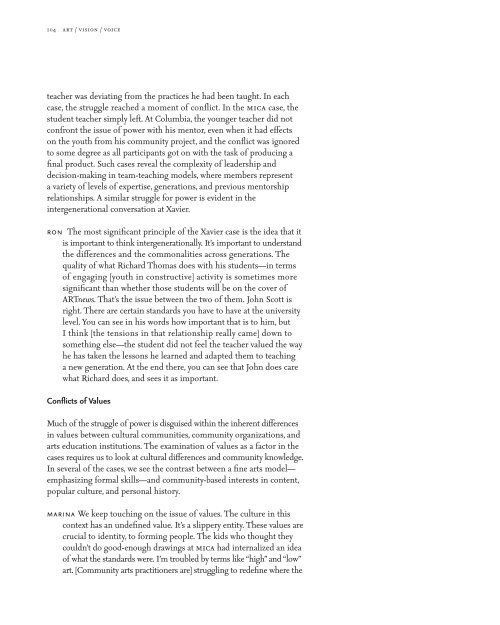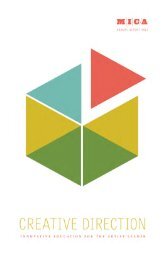art/vision/voice - Maryland Institute College of Art
art/vision/voice - Maryland Institute College of Art
art/vision/voice - Maryland Institute College of Art
You also want an ePaper? Increase the reach of your titles
YUMPU automatically turns print PDFs into web optimized ePapers that Google loves.
104 <strong>art</strong> / <strong>vision</strong> / <strong>voice</strong><br />
teacher was deviating from the practices he had been taught. In each<br />
case, the struggle reached a moment <strong>of</strong> conflict. In the mica case, the<br />
student teacher simply left. At Columbia, the younger teacher did not<br />
confront the issue <strong>of</strong> power with his mentor, even when it had effects<br />
on the youth from his community project, and the conflict was ignored<br />
to some degree as all p<strong>art</strong>icipants got on with the task <strong>of</strong> producing a<br />
final product. Such cases reveal the complexity <strong>of</strong> leadership and<br />
decision-making in team-teaching models, where members represent<br />
a variety <strong>of</strong> levels <strong>of</strong> expertise, generations, and previous mentorship<br />
relationships. A similar struggle for power is evident in the<br />
intergenerational conversation at Xavier.<br />
ron The most significant principle <strong>of</strong> the Xavier case is the idea that it<br />
is important to think intergenerationally. It’s important to understand<br />
the differences and the commonalities across generations. The<br />
quality <strong>of</strong> what Richard Thomas does with his students—in terms<br />
<strong>of</strong> engaging [youth in constructive] activity is sometimes more<br />
significant than whether those students will be on the cover <strong>of</strong><br />
ARTnews. That’s the issue between the two <strong>of</strong> them. John Scott is<br />
right. There are certain standards you have to have at the university<br />
level. You can see in his words how important that is to him, but<br />
I think [the tensions in that relationship really came] down to<br />
something else—the student did not feel the teacher valued the way<br />
he has taken the lessons he learned and adapted them to teaching<br />
a new generation. At the end there, you can see that John does care<br />
what Richard does, and sees it as important.<br />
Conflicts <strong>of</strong> Values<br />
Much <strong>of</strong> the struggle <strong>of</strong> power is disguised within the inherent differences<br />
in values between cultural communities, community organizations, and<br />
<strong>art</strong>s education institutions. The examination <strong>of</strong> values as a factor in the<br />
cases requires us to look at cultural differences and community knowledge.<br />
In several <strong>of</strong> the cases, we see the contrast between a fine <strong>art</strong>s model—<br />
emphasizing formal skills—and community-based interests in content,<br />
popular culture, and personal history.<br />
marina We keep touching on the issue <strong>of</strong> values. The culture in this<br />
context has an undefined value. It’s a slippery entity. These values are<br />
crucial to identity, to forming people. The kids who thought they<br />
couldn’t do good-enough drawings at mica had internalized an idea<br />
<strong>of</strong> what the standards were. I’m troubled by terms like “high” and “low”<br />
<strong>art</strong>. [Community <strong>art</strong>s practitioners are] struggling to redefine where the
















